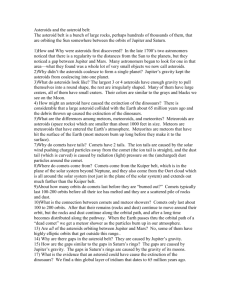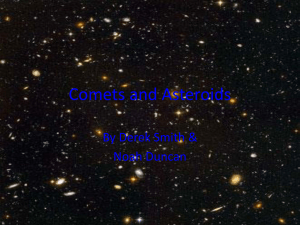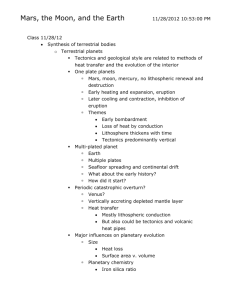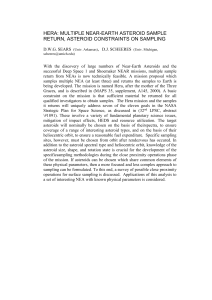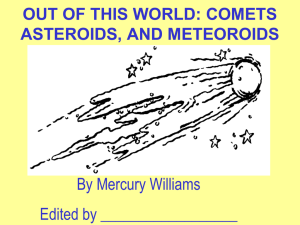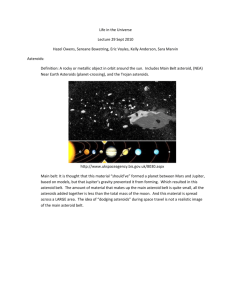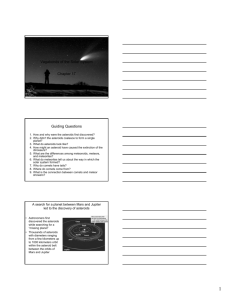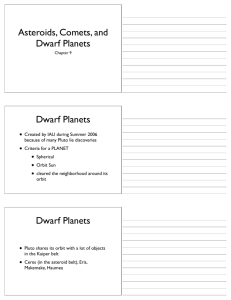Chapter 12 Asteroids, Comets, and Dwarf Planets What are
advertisement
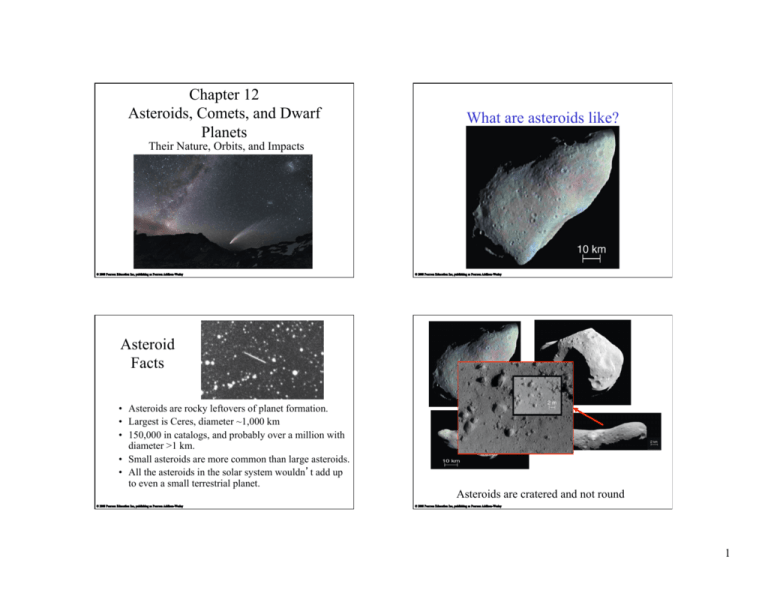
Chapter 12 Asteroids, Comets, and Dwarf Planets What are asteroids like? Their Nature, Orbits, and Impacts Asteroid Facts • Asteroids are rocky leftovers of planet formation. • Largest is Ceres, diameter ~1,000 km • 150,000 in catalogs, and probably over a million with diameter >1 km. • Small asteroids are more common than large asteroids. • All the asteroids in the solar system wouldn t add up to even a small terrestrial planet. Asteroids are cratered and not round 1 Asteroids with Moons • Some large asteroids have their own moon • Asteroid Ida has a tiny moon named Dactyl Missions to Asteroids Types of Asteroids (based on composition) • C-type: large fraction of carbon - dark (low reflectivity), 75% of all asteroids - remnants of solar system formation? • S-type: large fraction of silicates - standard rocky material, 15% of asteroids • M-type: large fraction of iron, nickel - standard rocky material, ~10% of asteroids Gaspra • Galileo (en route to Jupiter) - flyby of Gaspra, Ida (S-types) • NEAR (Near Earth Asteroid Rendezvous): - flyby of Mathilde (C- type) - orbited Eros (and landed!) Dimensions: 16 x 12 km(about the same size as Deimos) - colors have been enhanced 2 Mathilde Eros Rotation (from NEAR) - dimensions: 59 x 47 km - C type, low density (1.4 g/cm3), loosely packed Density of Asteroids Asteroid Orbits • Measuring orbit of asteroid s moon tells us asteroid s mass • Mass and size tell us asteroid s density • Most asteroids orbit in a belt between Mars and Jupiter • Some asteroids are solid rock; others just piles of rubble • Orbits of near-Earth asteroids cross Earth s orbit • Trojan asteroids are in Jupiter s orbit 3 Thought Question Why are there very few asteroids beyond Jupiter s orbit? A. There was no rocky material beyond Jupiter s orbit. B. The heaviest rocks sank towards the center of the solar system. C. Ice could form in the outer solar system. D. A passing star probably stripped away all of those asteroids, even if they were there at one time. Why is there an asteroid belt? Thought Question Why are there very few asteroids beyond Jupiter s orbit? A. There was no rocky material beyond Jupiter s orbit. B. The heaviest rocks sank towards the center of the solar system. C. Ice could form in the outer solar system. D. A passing star probably stripped away all of those asteroids, even if they were there at one time. Orbital Resonances • Asteroids in orbital resonance with Jupiter experience periodic nudges • Eventually those nudges move asteroids out of resonant orbits, leaving gaps in belt 4 Origin of Asteroid Belt Where do meteorites come from? • Rocky planetesimals between Mars and Jupiter did not accrete into a planet. • Jupiter s gravity, through orbital resonances, stirred up asteroid orbits and prevented their accretion into a planet. Meteor Terminology Meteorite Impact • Meteoroid: a rock in space • Meteor: a bright trail left by a meteoroid falling through the atmosphere ( shooting star ) • Fireball: a very bright meteor • Meteorite: A rock from space that survives the Earth s atmosphere and is found on the ground. Chicago, March 26, 2003 5 Meteorite Types Primitive Meteorites 1) Primitive: Unchanged in composition since they first formed 4.6 billion years ago. 2) Processed: Younger, have experienced processes like volcanism or differentiation. Processed Meteorites Meteorites from Moon and Mars • A few meteorites arrive from the Moon and Mars • Composition differs from the asteroid fragments. • A cheap (but slow) way to acquire moon rocks and Mars rocks. 6 What are comets like? Comet Halley (1986) Comet Hale-Bopp (1997) Comet Facts • Formed beyond the frost line, comets are icy counterparts to asteroids. • Nucleus of comet a dirty snowball • Most comets do not have tails. • Most comets remain perpetually frozen in the outer solar system. • Only comets that enter the inner solar system grow tails. 7 1996 X-mas Comet, observed by SOHO Comet Hyakutake - 1996 Giotto Image of Halley s Nucleus Nucleus of Comet • A dirty snowball • Source of material for comet s tail 8 Deep Impact • Mission to study nucleus of Comet Tempel 1 • Projectile hit surface on July 4, 2005 - surface is very dark, ice evaporates from crevasses - jets of streaming material alter the orbit slightly Anatomy of a Comet • Many telescopes studied aftermath of impact Growth of Tail • Coma is atmosphere that comes from heated nucleus • Plasma tail is gas escaping from coma, pushed by solar wind • Dust tail is pushed by photons 9 Comets eject small particles that follow the comet around in its orbit and cause meteor showers when Earth crosses the comet s orbit. - Meteor showers occur on the same day each year Where do comets come from? Only a tiny number of comets enter the inner solar system - most stay far from the Sun Oort cloud: On random orbits extending to about 50,000 AU Kuiper belt: On orderly orbits from 30-100 AU in disk of solar system 10 How did they get there? Kuiper Belt Objects • Kuiper belt comets formed in the Kuiper belt: flat plane, aligned with the plane of planetary orbits, orbiting in the same direction as the planets. • Oort cloud comets were once closer to the Sun, but they were kicked out there by gravitational interactions with jovian planets: spherical distribution, orbits in any direction. Pluto s Orbit • Pluto will never hit Neptune, even though their orbits cross, because of 3:2 orbital resonance • Neptune orbits three times during the time Pluto orbits twice Is Pluto a Planet? • • • • • By far the smallest of the original planets. Not a gas giant like other outer planets. Has an icy composition like a comet. Has a very elliptical, inclined orbit. Pluto has more in common with comets than with the eight major planets 11 Other Icy Bodies - Dwarf Planets • There are many icy objects like Pluto on elliptical, inclined orbits beyond Neptune. • The largest of these, Eris, was discovered in 2005, and is even larger than Pluto. What are the large objects of the Kuiper belt like? Kuiper Belt Objects • These large, icy objects have orbits similar to the smaller objects in the Kuiper Belt that become short period comets What is Pluto like? • Its moon Charon is nearly as large as Pluto itself (probably made by a major impact) • Pluto is very cold (40 K) • Pluto has a thin nitrogen atmosphere that will refreeze onto the surface as Pluto s orbit takes it farther from the Sun. 12 Other Kuiper Belt Objects Are Pluto and Eris planets? • Most have been discovered very recently so little is known about them. • NASA s New Horizons mission will study Pluto and a few other Kuiper Belt object in a planned flyby. Pluto and Eris Have we ever witnessed a major impact? • Pluto s size was overestimated after its discovery in 1930, and nothing of similar size was discovered for several decades • Now other large objects have been discovered in Kuiper Belt, including Eris • The International Astronomical Union (IAU) now classifies Pluto and Eris as dwarf planets 13 Animation of impact with Jupiter Comet SL9 caused a string of violent impacts on Jupiter in 1994, reminding us that catastrophic collisions still happen. Tidal forces tore it apart during a previous encounter with Jupiter Impact plume from a fragment of comet SL9 rises high above Jupiter s surface Dusty debris at an impact site 14 Several impact sites Did an impact kill the dinosaurs? Impact sites in infrared light Mass Extinctions • Fossil record shows occasional large dips in the diversity of species: mass extinctions. • Most recent was 65 million years ago, ending the reign of the dinosaurs. 15 Iridium: Evidence of an Impact • Iridium is very rare in Earth surface rocks but often found in meteorites. • Luis and Walter Alvarez found a worldwide layer containing iridium, laid down 65 million years ago, probably by a meteorite impact. • Dinosaur fossils all lie below this layer Consequences of an Impact • Meteorite 10 km in size would send large amounts of debris into atmosphere. • Debris would reduce sunlight reaching Earth s surface. • Resulting climate change may have caused mass extinction. Iridium Layer No dinosaur fossils in upper rock layers Thin layer containing the rare element iridium Dinosaur fossils in lower rock layers Likely Impact Site • Geologists have found a large subsurface crater about 65 million years old in Mexico 16 Comet or asteroid about 10 km in diameter approaches Earth 17 Is the impact threat a real danger or media hype? Facts about Impacts • Asteroids and comets have hit the Earth. • A major impact is only a matter of time: not IF but WHEN. • Major impacts are very rare. • Extinction level events ~ millions of years. • Major damage ~ hundreds of years. Tunguska, Siberia: June 30, 1908 A ~40 meter object disintegrated and exploded in the atmosphere 18 Frequency of Impacts • Small impact happen almost daily. • Impacts large enough to cause mass extinctions are many millions of years apart Meteor Crater, Arizona: 50,000 years ago (50 meter object) The asteroid with our name on it • We haven t seen it yet. • Deflection is more probable with years of advance warning. • Control is critical: breaking a big asteroid into a bunch of little asteroids is unlikely to help. • We get less advance warning of a killer comet… What are we doing about it? • Stay tuned to http://impact.arc.nasa.gov 19



